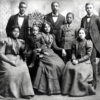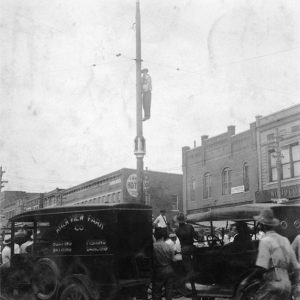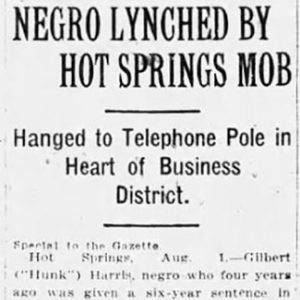calsfoundation@cals.org
Gilbert Harris (Lynching of)
On August 1, 1922, a mob of as many as 500 people broke into the Hot Springs (Garland County) jail and, brandishing guns, forcibly took a man and lynched him at the triangle in front of the Como Hotel located at the intersection of Central and Ouachita avenues. In his memoirs, Roswell Rigsby (1910–2001), an eyewitness to the lynching, stated, “I believe this was the last lynching in Hot Springs, at least in public.” There are some conflicting reports as to the first name of the man lynched. There are references to his first name being Punk, Bunk, and Gilbert; however, all accounts list his last name as Harris.
Accounts of the hanging appeared in newspapers as far away as Portland, Oregon. One account of the lynching appeared in the August 2 issue of the New York Times, published as a “special” from Hot Springs. According to the article, Gilbert Harris, described as a “negro” twenty-eight years of age, was lynched in Hot Springs the morning after his arrest and after the death of Maurice Connally, described as age twenty-six and “a prominent young business man.” (Connally’s name is spelled a variety of ways in the various newspaper accounts.) The Times offered a quotation from the Sentinel Record of Hot Springs, in which it was stated: “The lynching in this city yesterday morning of the negro Harris will put an end to the house robberies that have been prevalent for some time. Aside from avenging the murder of Maurice Connally, the lynching will put fear into the criminal class which invades the homes of people.”
At least one eyewitness account described the lynching and its highly visible and social setting. At the time Rigsby witnessed the lynching, he was twelve years old and working as a newspaper boy. Previous to the lynching, he said that he had followed the reports of a series of burglaries that had been committed in the Quapaw Avenue neighborhood.
A comprehensive account of the lynching is derived from several official reports appearing in the Hot Springs New Era, a local newspaper. The New Era indicates that Harris had been arrested for the home burglary and murder of Connally. Within hours of the arrest, a crowd began to form at the city jail where Harris was being held. According to the report, Circuit Judge Scott Wood, Police Chief R. O. Sullivan, and Mayor Harry A. Jones pleaded with the crowd to go home and “let justice take its course” and that an “indictment would be returned and the negro given a speedy trial.” The crowd failed to disperse, so Chief Sullivan ordered his officers to retreat into the jail and bar the door. While some members of the crowd detained Sullivan, others broke in the side door of the jail, held the officers at gunpoint, and took Harris from the jail. The mob, described as numbering about 500 men, took Harris to Como Triangle, where the hanging was performed.
In seeking an understanding of the fast-paced events leading to the hanging, it is relevant to note that the New Era reported that Connally was a well-respected and prominent business owner and the nephew of the Garland County probate judge, Charles Davis. One further article listed the past criminal history of Harris, referring to his “bad record.”
Although there is no direct reference to the Ku Klux Klan being involved in this lynching, it is also noteworthy that a final report in the New Era dated August 3 provides considerable coverage to the Klan’s role in overseeing Connally’s funeral. This final report may lend substance to the eyewitness account that there was a sizable Ku Klux Klan march in Hot Springs during this timeframe.
The site where Harris and, previously, Will Norman were lynched is now occupied by the Hot Springs Confederate Monument.
For additional information:
“2 Negroes Lynched by Mobs in South.” New York Times, August 2, 1922, p. 19. Online at http://query.nytimes.com/gst/abstract.html?res=9B0CE6D61239EF3ABC4A53DFBE668389639EDE (accessed September 9, 2021).
“Gilbert Harris Hanged on Como Triangle Today.” Hot Springs New Era, Extra edition, August 1, 1922, p. 1.
Hanley, Ray. A Place Apart: A Pictorial History of Hot Springs, Arkansas. Fayetteville: University of Arkansas Press, 2011.
“Hot Springs Mob Lynches Negro.” Southwest Missourian, August 1, 1922, p. 1. Online at http://news.google.com/newspapers?nid=1893&dat=19220801&id=mScrAAAAIBAJ&sjid=rtMEAAAAIBAJ&pg=2529,10042 (accessed September 9, 2021).
“Hundreds Pay Last Tribute: Ku Klux Hold Service.” Hot Springs New Era, August 3, 1922, p. 1.
“Inquest Held Over Remains of Harris.” Hot Springs New Era, August 1, 1922, p. 1.
Lancaster, Guy. “Many a Civil Monster: Lynching and the Ku Klux Klan in Hot Springs, 1922.” The Record (2019): 4.1–4.22.
Rigsby, Malcolm L. “Memory of that Fateful Day in Hot Springs.” Arkansas Democrat-Gazette, August 31, 2014, p. 2H.
“ 2 Negroes are Lynched.” Morning Oregonian, August 2, 1922, p. 1. Online at http://oregonnews.uoregon.edu/lccn/sn83025138/1922-08-02/ed-1/seq-1/ (accessed September 9, 2021).
Malcolm L. Rigsby
Henderson State University



 Harris Lynching
Harris Lynching  Harris Lynching Article
Harris Lynching Article 



Comments
No comments on this entry yet.